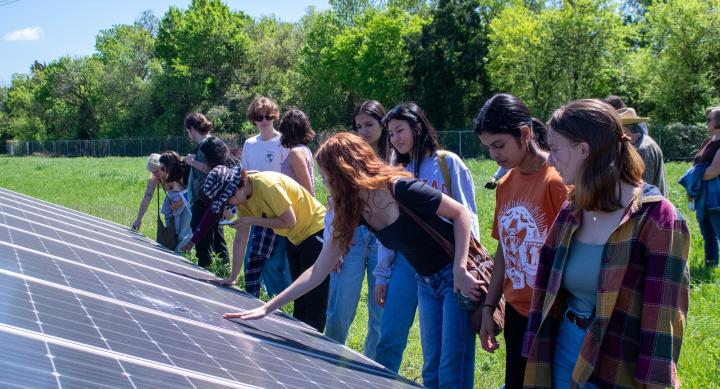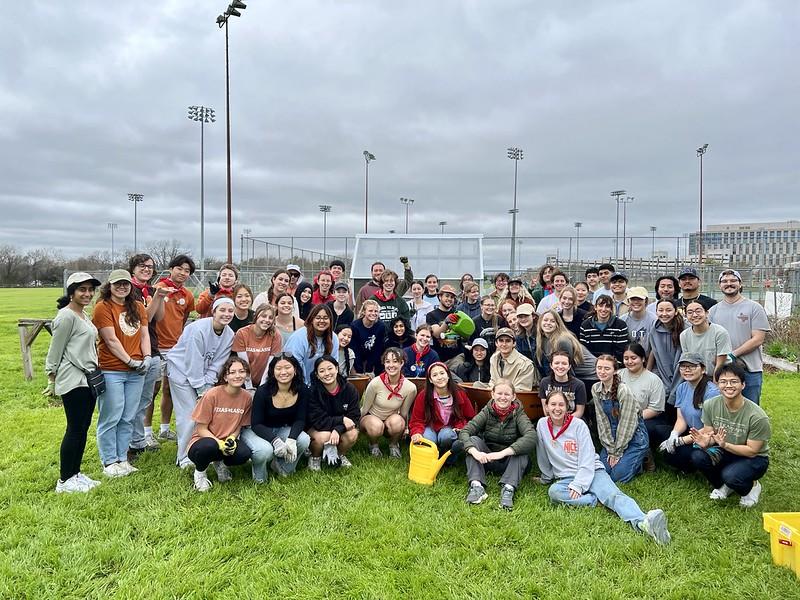
Connecting Academics to Real-World Projects
About Campus as a Living Lab
The UT Austin Campus as a Living Lab (CLL) program is where the physical university becomes the subject for student academic exploration. Students work alongside operational staff to support campus needs through research and collaborative projects. Faculty integrate real world initiatives into the course work creating more avenues for student engagement on-campus. While these type of experiences have been offered for years across campus, the CLL initiative seeks to create consistency and expand impact.
Projects with Real Impact
The Campus as a Living Lab initiative reinforces UT Austin as a space where ideas lead directly to action. By connecting research, operations, and community engagement, CLL projects turn sustainability goals into measurable progress across the university. These efforts help improve campus systems, from how we manage energy, water, and waste to how we design and maintain our shared spaces. Each project adds knowledge that can shape policies, influence planning, and create a more resilient built environment.
Beyond solving immediate challenges, these projects foster a culture of collaboration and innovation. They bring together students, faculty, and staff to address real issues in real time, strengthening UT’s role as a leader in the integrating the student and campus experience. The work done through CLL reminds us that lasting change starts locally—within the environments where we study, work, and live—and that the lessons learned here can ripple far beyond the Forty Acres.

Ways to Engage
Students engage on campus in countless ways that bring learning, creativity, and collaboration to life. Through CLL, students explore how the university operates as a small city with a dynamic community, studying everything from campus infrastructure and operations to the flow of people and events. By partnering with faculty and campus staff, students use the university itself as a learning environment, testing ideas, collecting data, and proposing real improvements. This approach encourages cross-disciplinary thinking and shows that innovation at UT isn’t limited to labs or classrooms; it happens in stadiums, concert halls, power plants, greenhouses, and every corner of the Longhorn Community.
Project Types
Research assistantship on a faculty-led project connected to a campus need
Research assistantships involve students working individually or as a team on a faculty-led research project. In a research assistantship, the lead faculty member/PI on the project should be willing to provide mentorship and direction to the student, and to assign a grade for course credit the student may be enrolled in. Depending on the size and structure of the research project, others on the research team (staff or graduate students) may help with supervision of students’ day-to-day work on the project.
Internship or research-internship
In an internship, students work directly with a staff member who supervises student work within an office or unit. Internships may be paid or unpaid, and students may or may not receive academic credit for internship experiences. Students receiving credit would have a faculty instructor or mentor separate from the internship site assigning a grade for the experience. Typically, students would have a regular schedule (hours requirements vary across campus, depending on the credit students are receiving, with 10 hours/week as the average). Research-internships are structured similarly, but involve students working on a specific research project to address a need in the organization, with students working in close communication and partnership with the organization to develop and pursue the project.
Organized class working on a project or assignment related to a campus need
The campus office/unit would work directly with a faculty member who is interested in incorporating assignments, projects, or other involvement addressing the campus need into the course requirements and schedule.

Propose a Campus Need
For faculty and staff only, thank you for your interest in creating a Campus as a Living Lab (CLL) project at UT Austin!
Use the Campus Need Proposal form to pitch a campus need to be addressed through a student-centered experiential learning opportunity. By submitting this proposal, you are indicating that:
You have a project directly tied to your work at UT where you see potential for student involvement
You or another member of your department is willing to serve as the primary liaison or contact for this project.
Once you've submitted your Campus Need Proposal, a staff member from the Office of Sustainability will be in touch to schedule a follow-up meeting.

Share Your Project Story
The Office of Sustainability is creating a Project Database on its website to highlight previous and ongoing Campus as a Living Lab (CLL) experiences. CLL is a framework that integrates academic research/coursework with campus operations. Students and faculty partner directly with staff who manage energy, water, health, construction, safety, waste, and land systems, using the campus as both a subject and a partner in academic exploration. We know many faculty and staff already incorporate experiential learning and living lab methods into their work through staff-led tours for groups of students, hiring or mentoring interns, collaborating with courses, partnering with student clubs, and much more. We are here to compile university-wide documentation of these experiences and promote your hard work. Please help us by sharing your experiences and how you have turned UT into a living laboratory for student learning.
Want to know more or have questions? Contact us! Sustainability@austin.utexas.edu
